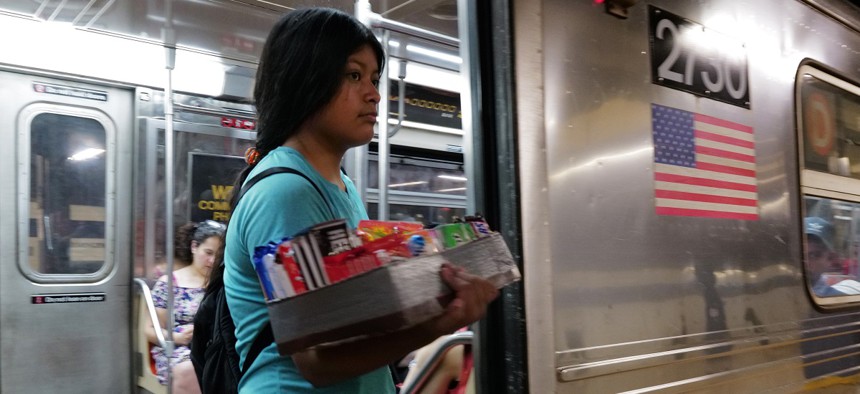Opinion
Opinion: Who is making immigrant youth in NYC a priority?
Homeless agencies are, but they are at their breaking point and need more resources.

A migrant teenager sells candy on a New York City subway (Photo by Spencer Platt/Getty Images)
Homeless youth in New York City are the most overlooked and ignored, especially the population of teenagers and young adults. Our failure to see these young people results in a lack of funding for services and options designed for them. For the many immigrant youth arriving in the city, there are even fewer resources and the social service agencies designated to help them are at a dire crossroads. How can we aptly serve this population when the city’s ever-changing policies do not offer viable, long-term solutions to move these youth to safety and stability?
For single individuals it is already an uphill battle to obtain a shelter placement when families are given first consideration. Following their 30-day stay in a city shelter for newly arrived immigrants, young people are discharged to the street and are not allowed equal access to Department of Homeless Services shelters, due to their immigration status. While immigrant youth are welcomed in the city’s youth shelters, the number of youth shelter beds was already woefully inadequate even before this new influx of thousands more young people in need.
Funding and proper support for these incoming youth is imperative to give them a chance to rebuild their lives. The treacherous journeys these individuals made thus far – the majority coming through the U.S.-Mexican border and bussed from southern territory states (i.e., Florida, Texas) – in addition to the trauma they have endured, is increased by further displacement when they arrive here. Homeless youth who are U.S. citizens already have a difficult time securing housing, due to being left out of city resources for all homeless New Yorkers [note: homeless youth in Department of Youth & Community Development programs do not have equal access to housing vouchers, New York City Housing Authority housing, or supportive housing]. For non-English speaking non-citizens who are new to this country and on their own, being denied access to shelter means they are literally left out in the cold.
At Safe Horizon’s Streetwork Project, we have been inundated with the arrival of youth at our doors daily, the vast majority of whom have completed the 30-day migrant shelter stay limit and now have nowhere to go. These young people are without a home, without warm clothes, without food, without financial resources of any kind. They are cold, hungry, and afraid. And they are kids.
For our staff, and our sister agencies, the current situation is appalling. We treat every young person who comes through our doors with care and compassion. We offer hot food, showers, clothing, respite, and a community. But at the end of the day when we have nowhere to send them at night, it is heartbreaking.
Not only that, these days we just don’t have the space to accommodate the very high need during the day. The mental toll of having to constantly turn away immigrant youth from our doors due to capacity issues and limited available resources is increasingly heavy. Imagine the pain of staff who hail from the same countries of some of the immigrants (many from West Africa) when they have to give them the news that we cannot offer them solutions that can sufficiently help them move out of the crisis they are currently in?
Our priority as service providers for immigrant youth is making sure we serve them with humanity. For most who view them as a burden, we want them to know we see them as the human beings that they are who deserve respect and an opportunity to succeed. The city’s immigrant shelters and temporary shelter policies – shipping new arrivals from one place to another and leaving them on the street without any regard – are inhumane and unsustainable.
We want our city and state leaders to hear our plea: we need you to make youth a priority in your policymaking.
First, the Right to Shelter mandate is for everyone across the board, immigrants and immigrant youth included. Second, in addition to housing, the city should add youth-specific, culturally and linguistically appropriate resources such as case management, counseling, medical care and job-readiness training. Third, more funding to organizations like Safe Horizon who serve to fill this gap including to DYCD, without any possibility of cuts, will help ensure these immigrant youth do not end up in a revolving door of hopelessness. Finally, the provision of pro bono immigration help to assist immigrant youth with navigating the complex immigration system and applying for benefits they may qualify for would all be major steps that can significantly impact the life trajectory of each young person currently on the street.
For 40 years, Safe Horizon’s Streetwork Project has worked with a population so often ignored, young people, made invisible in New York City. Perhaps now that there are hundreds of them lining city blocks, hopefully waiting for news that something has changed, we can open our eyes and see all homeless youth – those born here and those born abroad – and give a damn.
Sebastien Vante is the associate vice president of the Safe Horizon Streetwork Project.
NEXT STORY: Commentary: Seizing the opportunity to improve contracting
